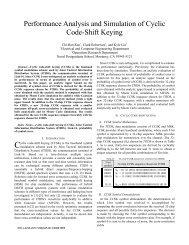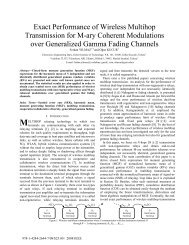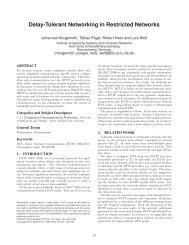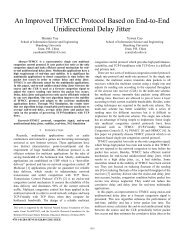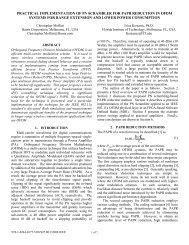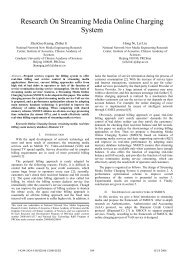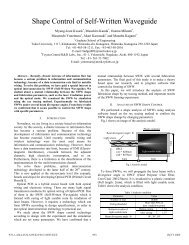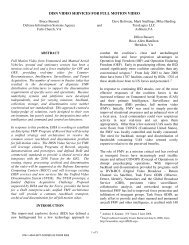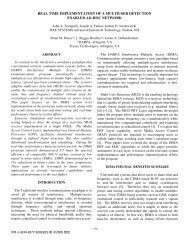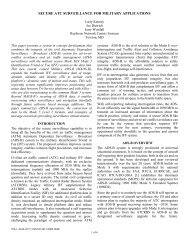2. Application Research on 3G Complex Scrambling Code
2. Application Research on 3G Complex Scrambling Code
2. Application Research on 3G Complex Scrambling Code
You also want an ePaper? Increase the reach of your titles
YUMPU automatically turns print PDFs into web optimized ePapers that Google loves.
<str<strong>on</strong>g>Applicati<strong>on</strong></str<strong>on</strong>g> <str<strong>on</strong>g>Research</str<strong>on</strong>g> <strong>on</strong> <strong>3G</strong> <strong>Complex</strong><br />
<strong>Scrambling</strong> <strong>Code</strong><br />
Fu Haiyang, Chen yu, Xu Sheng<br />
School of Communicati<strong>on</strong>s and Informati<strong>on</strong> Engineering<br />
Nanjing University of Posts and Telecommunicati<strong>on</strong>s, Nanjing 210003, Jiangsu, P.R. China.<br />
e-mail: fuhy@njupt.edu.cn<br />
Abstract-Employing <strong>Complex</strong> <strong>Scrambling</strong> <strong>Code</strong> (CSC) would<br />
introduce Quasi-Orthog<strong>on</strong>al Address <strong>Code</strong> Interference (QOACI)<br />
in QPSK I-Q sub-channel, resulting in the decrease of the<br />
communicati<strong>on</strong> capacity, presenting two ameliorated scrambling<br />
code schemes, then according to the simulati<strong>on</strong> result, because of<br />
the more complicated c<strong>on</strong>stellati<strong>on</strong>s, the capacity would decline<br />
corresp<strong>on</strong>dingly.<br />
Keywords-<strong>Complex</strong> <strong>Scrambling</strong> <strong>Code</strong> (CSC); Quasi-Orthog<strong>on</strong>al<br />
Address <strong>Code</strong> Interference (QOACI); cell capacity; C<strong>on</strong>stellati<strong>on</strong><br />
I. INTRODUCTION<br />
The 3rd generati<strong>on</strong> mobile communicati<strong>on</strong> system should be<br />
designed to serve mainly for wireless internet service, which<br />
requires downlink capacity several times higher than that of<br />
uplink. At this point, the three existing mainstream <strong>3G</strong><br />
standards involve some serious defects [1].<br />
CDMA system has approximately equalled up and down link<br />
capacity [2]. Furthermore, increasing the transmissi<strong>on</strong> power,<br />
the system self-interference is increased corresp<strong>on</strong>dingly,<br />
making no c<strong>on</strong>tributi<strong>on</strong> to system capacity. The frequency<br />
spectrum efficiency E f of CDMA in a cell is very low, since it<br />
is impossible to enhance E f by increasing transmissi<strong>on</strong> power.<br />
Although some advanced techniques could improve the<br />
performance, the system performance-to-price ratio would drop<br />
rapidly. That’s the primary cause of ceasing cdma2000 3x<br />
standard, discarding CDMA mode and 1x EV-DV (Evoluti<strong>on</strong>-<br />
Data &Voice), and turning to EV-DO (Evoluti<strong>on</strong>-Data Only),<br />
which employs TDMA mode. The c<strong>on</strong>versi<strong>on</strong> of cdma2000<br />
standard also reflects the irrati<strong>on</strong>ality of symmetric <strong>3G</strong> FDD<br />
frequency distributi<strong>on</strong> scheme defined by ITU, since another<br />
independent downlink carrier is needed. We should be<br />
cognizant of the incompleti<strong>on</strong> existing in <strong>3G</strong> standards, and<br />
further study the standards so as to improve the performance of<br />
practical systems.<br />
The two main <strong>3G</strong> standards-WCDMA and cdma2000 1x<br />
employ CSC respectively. CSC has been a widely studied topic<br />
over many years [3],[4]. But the focus was primarily <strong>on</strong><br />
periodic correlati<strong>on</strong> properties. According to the analysis of<br />
this article, CSC can functi<strong>on</strong> as c<strong>on</strong>venti<strong>on</strong>al SC. Additi<strong>on</strong>ally<br />
CSC would produce two orthog<strong>on</strong>al transmissi<strong>on</strong> diversity<br />
(OTD) signals, perhaps it could be used to overcome the effect<br />
of frequency selective fade which results from multi-path fade,<br />
but it would enlarge the transmitting power, which would<br />
decline the system capacity, since CDMA system is a self-<br />
S1<br />
S2<br />
SN<br />
I1<br />
Q<br />
1<br />
M1<br />
⊗<br />
W1<br />
1.2288Mcps<br />
⊗<br />
M<br />
<br />
2<br />
M 3<br />
⊗<br />
G1<br />
⊗<br />
interference system. Another main c<strong>on</strong>clusi<strong>on</strong> of our analysis is<br />
that CSC would introduce cell QOACI in downlink, so that the<br />
capacity of a single-carrier cell would drop to the half of the<br />
former system. This paper presents two ameliorated scrambling<br />
code schemes. According to the simulati<strong>on</strong> result and reference<br />
[4],[5], we analyse the variety of c<strong>on</strong>stellati<strong>on</strong> employing these<br />
three different SC schemes, then find that more complicated<br />
c<strong>on</strong>stellati<strong>on</strong> would result in decline of the power efficiency of<br />
modulati<strong>on</strong>, which could decline the communicati<strong>on</strong> capacity,<br />
since CDMA system is a self-interference system.<br />
II. THE DEFINITION AND FUNCTION OF CSC<br />
Fig.1 shows the CSC part in BS transmitter of cdma2000 1x<br />
system, in which IT and Q T are the summati<strong>on</strong>s of signals of<br />
N users. Assumed that all users are in voice service with data<br />
rate of 9.6kbps in IS-95 system, the maximal user number<br />
Nmax [6].<br />
≈ 26, actually, the available user number N=13, see as<br />
According to the definiti<strong>on</strong>, the relati<strong>on</strong> between CSC inputs<br />
and outputs could be showed as follows:<br />
N N <br />
(1)<br />
<br />
Im = IT⋅PNI −QT⋅ PNQ = Ik⋅WkPNI − Qk⋅WkPNQ <br />
k= 1 k= 1 <br />
Qm = QT⋅ PNI + IT⋅PNQ M<br />
4<br />
I12<br />
Q12<br />
I22<br />
Q<br />
22<br />
I N 2<br />
QN<br />
2<br />
To facilitate derivati<strong>on</strong>, assuming that G k =1 in Fig.1, the<br />
similar process will act <strong>on</strong> later derivati<strong>on</strong>s. Analyzing<br />
equati<strong>on</strong> (1) could draw the following c<strong>on</strong>clusi<strong>on</strong>. Firstly, the<br />
input of QPSK modulator could be divided into two orthog<strong>on</strong>al<br />
2PSK input signals Im, Q m , which c<strong>on</strong>tain both QT, IT<br />
respectively. The orthog<strong>on</strong>al transmitting diversity (OTD)<br />
signals for QT, I T , whose correlati<strong>on</strong> property is weak, could<br />
effectively overcome multi-path transmissi<strong>on</strong> loss. This<br />
1<br />
2<br />
IT<br />
QT<br />
PN I PNQ<br />
Fig.1. CSC part in BS transmitter of cdma2000 1x system<br />
1-4244-2424-5/08/$20.00 ©2008 IEEE 1374<br />
ICCS 2008<br />
Im<br />
Qm<br />
S0
S 1<br />
S2<br />
S3<br />
M1 2 M<br />
⊗ ⊗<br />
W<br />
M 3<br />
4 M<br />
G<br />
1<br />
1<br />
⊗ ⊗<br />
W2<br />
M 6<br />
5<br />
M<br />
W3<br />
G2<br />
⊗ ⊗<br />
G3<br />
2<br />
IT<br />
QT<br />
<strong>Complex</strong><br />
scrambling<br />
code<br />
operati<strong>on</strong> is applicable to down and up link respectively. Fig.2<br />
shows the structure of uplink transmitter.<br />
are not synchr<strong>on</strong>ous with PNI, PN Q seriously. Despite ORD<br />
would double the amplitude of receiving signal I T , it also<br />
increases the transmissi<strong>on</strong> power and the QOACI, which has<br />
the effect of noise corresp<strong>on</strong>dingly, so the efficiency of OTD<br />
should be doubted. The effect of these two QOACI terms can’t<br />
be omitted though they have opposite signs since they have the<br />
feature of random noise. Another reas<strong>on</strong> is the effect of multipath<br />
propagati<strong>on</strong>.<br />
If we want to demodulate the signal IT in Fig.1 from I TR by<br />
decoding the Walsh address code, there is:<br />
I = I ⋅W<br />
1R TR 1<br />
= 2IT⋅<br />
W1+ ( −QT⋅PNQ⋅ PNIL+ QT⋅PNI ⋅PNQL) ⋅W1<br />
= 2I1+ 2Ik⋅Wk⋅<br />
W1+ ( −QT⋅PNQ⋅ PNIL+ QT⋅PNI⋅PNQL) ⋅W1<br />
k≠1<br />
Apparently, the first term in the formula is the signal we<br />
need, the sec<strong>on</strong>d term is the orthog<strong>on</strong>al address code<br />
interference (OACI), and the third term is the CSC QOACI,<br />
whose influence awfully overruns OACI. It is easy to prove<br />
that <strong>on</strong>ly OACI exists in the downlink of CDMA IS-95 system<br />
for there is no CSC. Later, we will prove that the influence of<br />
CSC QOACI would reduce the downlink capacity to half of the<br />
system without CSC, even less than IS-95. IS-95 system uses<br />
Im<br />
Qm<br />
Q<br />
P<br />
S<br />
K<br />
Fig.<str<strong>on</strong>g>2.</str<strong>on</strong>g> CSC part in uplink transmitter of cdma2000 1x system<br />
S0<br />
(3)<br />
2× 2PSK OTD, the informati<strong>on</strong> in two 2PSK signals are the<br />
same.<br />
IV. DOWNLINK CAPACITY OF SYSTEM WITH CSC<br />
Assume that all users are voice users with full rate to<br />
simplify the calculati<strong>on</strong> of downlink capacity. Based <strong>on</strong><br />
receiving signal to noise ratio of downlink, we could list this<br />
formula:<br />
E<br />
mPt/ ( LP⋅N⋅R b<br />
b)<br />
= ≥d(4)<br />
Nt F⋅ Nth+ ( α+ β)<br />
Pt/ ( Lp⋅W) −mPt/ ( Lp⋅N⋅W) Then deducing the maximal user number<br />
mW / ( Rb⋅ d)<br />
+ 1<br />
Nmax<br />
≈<br />
<br />
(5)<br />
α + β<br />
N max is the basic definiti<strong>on</strong> of cell capacity, denoting the<br />
III. THE QOACI INTRODUCED BY CSC maximal number of users who can call simultaneously in a cell<br />
Employing CSC will introduce QOACI in the process of<br />
descrambling IT, Q T in downlink, something similar to address<br />
with <strong>on</strong>e carrier. mP t is the total power for traffic channels;<br />
value of m ranges from 0.71 to 0.76 [6]. We set m=0.76, here.<br />
code interference in uplink. That is to say, demodulating I1, Q1<br />
L p is the radio link loss; synchr<strong>on</strong>ous address code (SAC) is<br />
will introduce QOACI. At receiver, assume the output signals employed in the downlink of CDMA IS-95 system, soα = 0.5 .<br />
of QPSK coherent demodulator are Im, Q m to avoid more The practical meaning of equati<strong>on</strong> (4) is explicit: the numerator<br />
complicated expressi<strong>on</strong>. After descrambling and processing of shows the bit energy gained by the receiver<br />
orthog<strong>on</strong>al receiving diversity (ORD), Im, Q m are transformed α Pt / ( Lp ⋅W) −mPt / ( Lp ⋅N⋅W) term in denominator part<br />
as follows:<br />
ITR = Im⋅ PNIL+ Qm⋅PNQL = ( IT⋅PNI−QT⋅PNQ) ⋅ PNIL+ ( QT⋅ PNI+ IT⋅PNQ) ⋅PNQL<br />
(2)<br />
shows cell self-interference, and β Pt / Lp ⋅ W term is<br />
interferences produced by the neighbour cells. Facilitating the<br />
calculati<strong>on</strong>, introduce L p , use β to regulate the value of<br />
= 2IT−QT⋅PNQ⋅<br />
PNIL+ QT⋅PNI⋅PNQL interferences produced by the neighbour cells. Comm<strong>on</strong>ly, β<br />
In equati<strong>on</strong> (2), the local short scrambling codes PNIL , PNQL<br />
ranges from 0.04 to 1.778. In reference [6], β is equal to<br />
1.778.<br />
As an engineering estimating formula, equati<strong>on</strong> (5) is widely<br />
used in CDMA IS-95 system. The relati<strong>on</strong>ship between the<br />
interference produced by address code decoding and<br />
parameters α, β has not been exhibited in equati<strong>on</strong> (4). Fig.3<br />
simply shows Walsh address coding and short PN sequence<br />
scrambling in IS-95 system. Obviously, for user data IQ k , it is<br />
OTD. From this figure, there are:<br />
1375<br />
IQk<br />
⊗<br />
Wk<br />
PNQ I<br />
⊗<br />
PN<br />
⊗<br />
Im<br />
Qm<br />
S0<br />
Fig.3. Walsh address coding and short PN sequence scrambling<br />
in IS-95
N <br />
<br />
I = IQ ⋅W⋅PN <br />
m<br />
k = 1<br />
k k<br />
<br />
I<br />
N <br />
Qm = IQk ⋅Wk ⋅PN<br />
Q<br />
k = 1 <br />
By QPSK coherent demodulating at receiver, mr , mr<br />
I Q are<br />
obtained. Then after the process of descrambling and address<br />
code decoding, we gain the first user data:<br />
( mr IL mr QL )<br />
(6)<br />
IQ1 = I ⋅ PN + Q ⋅PN<br />
W1<br />
= 2IQ1+ 2 IQk ⋅Wk ⋅W<br />
(7)<br />
1<br />
k = 1<br />
IQ 1 is the user data we needed, and the sec<strong>on</strong>d term is<br />
synchr<strong>on</strong>ous address code interference depending <strong>on</strong> cell<br />
interference parameter α in equati<strong>on</strong> (4). C<strong>on</strong>sidering <strong>on</strong>e<br />
neighbour cell interference, an additi<strong>on</strong>al term should be added<br />
to the right hand of equati<strong>on</strong> (7):<br />
N N <br />
<br />
IN = IQ k⋅Wk⋅PNIN⋅ PNIL+ IQ k⋅Wk⋅PNQN⋅PNQL⋅W 1<br />
<br />
k= 1 k=<br />
1 <br />
<br />
<br />
N <br />
≈ 2<br />
IQk ⋅Wk ⋅PNIN<br />
⋅PNIL ⋅W<br />
(8)<br />
<br />
1<br />
k = 1 <br />
PNIN , PN QN are scrambling codes of the neighbour cell. This<br />
term shows the QOACI of the neighbour cell, and its effect is<br />
Eb<br />
defined by the parameter β in equati<strong>on</strong> (4).<br />
N t<br />
represented<br />
by equati<strong>on</strong> (4) is directly proporti<strong>on</strong>al to<br />
2<br />
( IQ1<br />
)<br />
N<br />
2 2 2<br />
( IQ ⋅W⋅ W ) + ( IQ ⋅W) ⋅( PN ⋅PN⋅W) <br />
k k 1 k k IN IL 1<br />
k≠ 1 k=<br />
1<br />
Equati<strong>on</strong> (5) should be rewritten when it is used in cdma2000<br />
1x system with CSC as following:<br />
mW / ( Rb⋅ d)<br />
+ 1<br />
Nmax<br />
≈<br />
<br />
(9)<br />
α + β + γ<br />
γ represents CSC QOACI.<br />
TABLE.I shows the value of N max depending <strong>on</strong> varied<br />
parameters in different systems. In the row of cdma2000 1x,<br />
we assume R b is 5.2kbps for c<strong>on</strong>sidering serial-parallel<br />
TABLE I<br />
The value of N max in different systems<br />
Nmax m<br />
W<br />
(MHz)<br />
Rb<br />
(kbps)<br />
D<br />
(dB) α β γ<br />
IS-95<br />
CDMA<br />
32 0.76 1.2288 10.4 4.5 0.5 0.5 0<br />
2000<br />
1x<br />
28 0.76 1.2288 5.2 4.5 0.5 0.8 1<br />
DAC-<br />
OTD<br />
36 0.76 1.2288 5.2 4.5 0.5 0.8 0.5<br />
SAC 64 0.76 1.2288 5.2 4.5 0.5 0.5 0<br />
1376<br />
Sk<br />
Ik<br />
Qk<br />
Wk<br />
W +<br />
k 1<br />
c<strong>on</strong>versi<strong>on</strong>, and set γ =1 for the QOACI existing in Im, Qm<br />
channels. In IS-95 system, set β =0.5. According to former<br />
deducti<strong>on</strong>, in system with CSC we should set β =1, but here,<br />
we set β =0.8. From the results of the table, we know that,<br />
although cdma2000 1x employs QPSK modulati<strong>on</strong>, the<br />
QOACI introduced by CSC decrease the capacity of the<br />
system, even less than IS-95 system.<br />
V. AMELIORATED CSC<br />
Fig.4 gives the first ameliorated CSC scheme for the<br />
downlink. We name it double address codes OTD (DAC-<br />
OTD). There are:<br />
I m = ( Ik ⋅ Wk + Qk ⋅Wk+<br />
1 ) PN I<br />
(10)<br />
Qm = ( Ik ⋅ Wk + Qk ⋅Wk+<br />
1 ) PNQ<br />
Analyzing expressi<strong>on</strong>s of Im, Q m , we can prove that this<br />
ameliorated scheme possesses the basic functi<strong>on</strong>s of OTD.<br />
Based <strong>on</strong> expressi<strong>on</strong> (10), Im, Q m for multi-channel DAC-<br />
OTD system are as following:<br />
N<br />
I<br />
m<br />
= ( I<br />
k<br />
⋅ W<br />
k<br />
+ Q<br />
k<br />
⋅W<br />
k + 1)<br />
PN<br />
I<br />
k = 1<br />
(11)<br />
N<br />
Q<br />
m<br />
= ( I<br />
k<br />
⋅ W<br />
k<br />
+ Q<br />
k<br />
⋅W<br />
k + 1)<br />
PN<br />
Q<br />
k = 1<br />
At receiving point, r<br />
I 1 of a certain user is obtained:<br />
( )<br />
I = I ⋅ PN + Q ⋅PN<br />
W<br />
1r mr IL mr QL 1L<br />
= 2I+ 2 I ⋅W ⋅ W + 2 Q W ⋅W<br />
1 k k 1L k k+ 1 1L<br />
k≠ 1 k=<br />
1<br />
N<br />
(12)<br />
The main dissimilarity with equati<strong>on</strong> (3) is that there is no<br />
QOACI in I 1r .<br />
Sk<br />
Ik<br />
Qk<br />
⊗<br />
⊗<br />
⊗ ⊗<br />
Gk<br />
Fig.4. DAC-OTD scheme<br />
⊗<br />
Wk Gk<br />
⊗<br />
⊗ ⊗<br />
PNI<br />
PNQ<br />
⊗ ⊗<br />
Fig.5. SAC scheme<br />
Im<br />
Qm<br />
⊗<br />
PN<br />
I<br />
PNQ<br />
⊗<br />
Im<br />
Q<br />
m<br />
S0<br />
S0
Fig.5 shows the sec<strong>on</strong>d ameliorated scheme of CSC in<br />
downlink. Named as single address code (SAC) scheme, the<br />
scheme eliminates OTD in the first scheme. By alike deducing<br />
methods of equati<strong>on</strong> (10) and (11), we know that:<br />
I1rr = I1+ Ik⋅Wk⋅W1L(13) k ≠1<br />
There is no address code interference from the other orthog<strong>on</strong>al<br />
channel of QPSK modulati<strong>on</strong>. The improvement of cell<br />
capacity means the enhancing of frequency spectrum<br />
efficiency. Since there is no OTD in this scheme, it would<br />
affect the performance of the service provided. To avoid this<br />
influence, we can add a transmissi<strong>on</strong> antenna at RF sender to<br />
achieve OTD and this may work better than CSC with single<br />
antenna.<br />
VI. CONSTELLATION AND PAR<br />
To make a promise, the number of user is N in a cell area,<br />
and the electrical level of each user is ± 1 . Before CSC, signals<br />
of all users would be added together, which would result in<br />
increasing the amount of possible electrical level to (N+1), and<br />
the maximum value is N. After calculating CSC, the amount of<br />
possible electrical level would increase to (2N+1), and the<br />
maximum value is 2N, it is a double of the numerical value<br />
before CSC. At the same time, CSC would cause big change of<br />
the c<strong>on</strong>stellati<strong>on</strong>. With DAC-OTD, the number of possible<br />
electrical level is (2N+1), and the maximum is 2N, it is the<br />
same as cdma2000 1x system with CSC, whereas there is a<br />
different c<strong>on</strong>stellati<strong>on</strong>, it is simpler than the <strong>on</strong>e with CSC, and<br />
the difficulty of demodulati<strong>on</strong> at the receiver is reduced. The<br />
result of SAC and cdma2000 1x system without CSC is<br />
equivalent. Fig.6 (a) ~(c) show the academic c<strong>on</strong>stellati<strong>on</strong>s of<br />
these three different SC schemes at the sender.<br />
As we know, increase of the amount of possible electrical<br />
Q<br />
−18<br />
18<br />
−18 18I<br />
I<br />
Fig.6 (a). CSC (N=9) Fig.6(b). DAC-OTD (N=9)<br />
Q<br />
−9<br />
Fig.6(c). SAC (N=9)<br />
9<br />
I<br />
Q<br />
1377<br />
level would bring <strong>on</strong> the enhancement of difficulty of<br />
demodulati<strong>on</strong> and decisi<strong>on</strong>. Especially the power efficiency of<br />
the modulati<strong>on</strong> would be dropped seriously according to the<br />
BER performance curve. If the c<strong>on</strong>stellati<strong>on</strong> given in Fig.7 had<br />
being used in CDMA system, it would introduce more selfinterference<br />
existed in CDMA system, resulting in the decline<br />
of system communicati<strong>on</strong> capacity. For example, the BER (Bit<br />
Error Rate) for decisi<strong>on</strong> of two and three electrical levels are<br />
Pe2= 1/2 erfc( SNR / 2)<br />
And<br />
30<br />
20<br />
10<br />
0<br />
-10<br />
-20<br />
-30<br />
-30 -20 -10 0 10 20 30<br />
Fig.7. C<strong>on</strong>stellati<strong>on</strong> of CSC at the sender(N=30)<br />
2<br />
Pe3= 3/4 erfc( SNR /(2 2)) −1/4<br />
erfc(3 SNR /(2 2))<br />
3 3<br />
Respectively, when Pe2=Pe3, SNR3 > SNR . It means that<br />
2<br />
increasing of the amount of electrical level would increase the<br />
needed SNR when the BER is equal, power at the sender must<br />
be increased corresp<strong>on</strong>dingly, since CDMA system is a selfinterference<br />
system, increasing of transmissi<strong>on</strong> power would<br />
certainly decline the cell capacity, we can obtain the<br />
c<strong>on</strong>firmati<strong>on</strong> from TABLE.I.<br />
Fig.7 and Fig.8 are the actual c<strong>on</strong>stellati<strong>on</strong>s with CSC<br />
scheme and SAC scheme at the sender. However, the<br />
simulati<strong>on</strong> result is quite different from the c<strong>on</strong>stellati<strong>on</strong> which<br />
we find in reference [6], which takes into account <strong>on</strong>ly <strong>on</strong>e user<br />
signal, but the adding of multiple user signals would introduce a<br />
series of problems which can not be ignored.<br />
Fig.7 and Fig.8 show that both the actual amount of electrical<br />
level and maximum value are smaller than academic values,<br />
whereas values of SAC scheme are still smaller than CSC<br />
scheme.<br />
20<br />
15<br />
10<br />
5<br />
0<br />
-5<br />
-10<br />
-15<br />
-20<br />
-20 -15 -10 -5 0 5 10 15 20<br />
Fig.8. C<strong>on</strong>stellati<strong>on</strong> of SAC at the sender(N=30)
30<br />
20<br />
10<br />
0<br />
-10<br />
-20<br />
-30<br />
-30 -20 -10 0 10 20 30<br />
Fig.9. C<strong>on</strong>stellati<strong>on</strong> of CSC(N=30)<br />
Fig.10. C<strong>on</strong>stellati<strong>on</strong> of DAC-OTD(N=30)<br />
25<br />
20<br />
15<br />
10<br />
5<br />
0<br />
-5<br />
-10<br />
-15<br />
-20<br />
-25<br />
-25 -20 -15 -10 -5 0 5 10 15 20 25<br />
Fig.11. C<strong>on</strong>stellati<strong>on</strong> of SAC(N=30)<br />
Fig.1<str<strong>on</strong>g>2.</str<strong>on</strong>g> Relati<strong>on</strong> between N and PAR<br />
1378<br />
The maximum of electrical level impacts the linear scope of<br />
transmissi<strong>on</strong> power amplifier and the input amplifier of receiver,<br />
the bigger the maximum, the larger the linear scope of these<br />
amplifiers, which may shorten the using time of battery in MS.<br />
For these aspects, the SAC scheme is better than others, as we<br />
can see from Fig.9~Fig.11, which show the c<strong>on</strong>stellati<strong>on</strong>s at the<br />
receiver. At the same time, we can find the c<strong>on</strong>stellati<strong>on</strong> with<br />
DAC-OTD scheme is simpler than the others at the receiver,<br />
and DAC-OTD scheme possesses the functi<strong>on</strong> of OTD.<br />
Fig.12 describes the relati<strong>on</strong> between the number of user and<br />
the PAR. C<strong>on</strong>trasting these three different N-PAR curves, PAR<br />
would fluctuate when the number of user changes and the PAR<br />
of SAC scheme get the smallest numerical value. PAR is an<br />
important aspect which we must take into account, when<br />
designing mobile teleph<strong>on</strong>es, biggish PAR could shorten the<br />
using time of MS battery. Biggish PAR and maximum electrical<br />
level are important causes, which will make the large power<br />
c<strong>on</strong>sumpti<strong>on</strong> and thermal noise of MS.<br />
VII. CONCLUSION<br />
This paper analyses the main functi<strong>on</strong>s of CSC in <strong>3G</strong><br />
standards and points out that the QOACI introduced by CSC<br />
would decrease system cell capacity to half of practicable<br />
capacity. Based <strong>on</strong> the analysis, we put forward two<br />
ameliorated schemes. And then, according to the complicated<br />
c<strong>on</strong>stellati<strong>on</strong>, which could decline the power efficiency of<br />
modulati<strong>on</strong>, then result in the decline of system capacity. SAC<br />
scheme would obtain the optimal performance at the aspects of<br />
PAR and modulati<strong>on</strong>, the linear scope of those amplifiers<br />
which it requests is smaller than that of other schemes, though<br />
there is no OTD in SAC scheme, we can add a transmissi<strong>on</strong><br />
antenna at RF sender to achieve the effect of OTD.<br />
[1].<br />
REFERENCES<br />
Fu Haiyang, etc., The directi<strong>on</strong> of <strong>3G</strong> developing must be corrected,”<br />
Telecommunicati<strong>on</strong>s Informati<strong>on</strong>, No.4, pp.12-16, 2006.<br />
[2]. Fu Haiyang, etc., “Performance analysis of WCDMA wireless access<br />
standard”, Fr<strong>on</strong>tiers of Electrical and Electr<strong>on</strong>ic Engineering in China,<br />
VOL.2, No.1, pp.57-62, 2007.<br />
[3]. P.V. Kumar, O. Moreno. “Polyphase sequences with periodic correlati<strong>on</strong><br />
properties better than binary sequences,” IEEE Trans. Inf. Theory, Vol.<br />
37, No.3, pp. 603-616, 1991.<br />
[4]. Vincent K N. Lau, “Average of Peak-to-Average Ratio (PAR) of IS95<br />
and CDMA2000 system-Single Carrier,” IEEE COMMUNICATION<br />
LETTERS, VOL.5, NO.4, APPIL 2001.<br />
[5]. Balasubramaniam Natarajan, “An Evoluti<strong>on</strong>ary to Designing <strong>Complex</strong><br />
Spreading <strong>Code</strong>s for DS-CDMA,” IEEE TRANSACTIONS ON<br />
WIRELESS COMMUNI-CATIONS, VOL.4, NO.5, SEPTEMBER 2005.<br />
[6]. Yang Dacheng, “cdma2000 1x Mobile Communicati<strong>on</strong> System,” Beijing:<br />
China Machine Press, 2003.<br />
[7]. Chenghua Hu, Shaoqian Li, “Performance of Parallel Interference<br />
Cancellati<strong>on</strong> for <strong>Complex</strong> Spreading CDMA systems in Fading<br />
Channels,” Proceedings of ICCT 2003.<br />
[8]. Jiangzhou Wang, “Performance of wideband CDMA systems with<br />
<strong>Complex</strong> Spreading and Imperfect Channel Estimati<strong>on</strong>,” IEEE<br />
JOURNAL ON SELECTED AREAS IN COMMUNICATIONS,<br />
VOL.19, NO.1, JANUARY 2001.



